Think of a classic Peruvian dinner, and arroz chaufa might not be the first thing that springs to mind. You might instead conjure up a plate of ceviche or a barbequed cuy (guinea pig!) washed down with a pisco sour.
Spend an evening in Lima, however, and you are just as likely to find yourself tucking into a hearty serving of unique Cantonese-style fried rice.
If you love fried rice, be sure to also check out Korean Bibambap and Korean Beef Bulgogi.

THE COOLIE INFLUX
What’s not known to most is that Peru has a sizeable Chinese community of over a million people, or roughly 4% of the national population. The community centered around Calle Capón in Lima’s Chinatown and has spawned around 4,500 chifa restaurants throughout the city.
These menus usually feature Chinese-Peruvian fused favorites like lomo saltado (stir-fried beef), chap suey (chop suey), sopa wantán (wonton soup) and tallarín saltado (lo mein) with the classic rice dish, arroz chaufa, at the center.
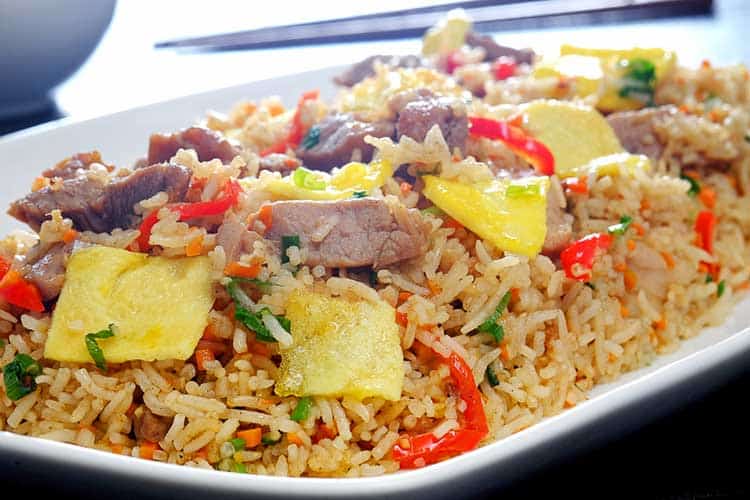
THE CHINESE MIGRATION
Unfortunately, the story of how Chinese immigrants first came to Peru is not a happy one.
The abolition of the Atlantic slave trade in the first half of the 19th century proved to be a terrible inconvenience for developers of the New World’s colonies. With a sudden paucity of manual workers needed to do the heavy lifting and African slaves no longer available, the main source of unskilled labor became Asia, where guileful local contractors jumped at the opportunity to capitalize on a gap in the market.
Various Chinese ports like Hong Kong, Macau and Guangzhou had already opened up to the west as a result of the Opium War of 1830-1840. From the mid 19th century onwards, these ports became hubs for the acquisition of indentured workhorses commonly known as Coolies, who were packed off and sent to plantations and mines in South America. Cuba and Peru were the two main destinations for the workers, taking altogether more than 260,000 men between 1847 and 1873.

COOLIE CRIMPS: NOT COOL AT ALL
The workers were usually poached by local agents – known as coolie crimps – who were an infamously unscrupulous lot. The merchant companies hiring the workers would pay the crimps a commission for each new recruit, a system which resulted in copious exploitation. Poor and displaced people in southern China were wooed with flimsy promises of prosperity abroad and dubious contracts that were rarely honored. And if these methods didn’t work, men were often drugged or kidnapped.
You May Also Like…
If you love rice dishes, you should also check out our other Peruvian fried rice with a Cantonese flair, or a Jordanian rice pilaf with lamb and yogurt sauce (mansaf with jameed).
Feel like eating your rice plain? Try our Korean Bibambap vegan with tofu and vegetables, or Korean Beef Bulgogi served with white rice.
Love chicken thighs? Try our saffron rice with marinated chicken thighs.
The first laborers started to arrive in Peru in 1849, the year that the country signed a treaty to accommodate the passage of indentured workers onto its shores. Men were sent to work in the cotton and sugar plantations, silver mines or the railroads up in the mountains. Their working conditions were harsh and said to be barely different from the previous African slaves. The contracts they were tied to usually lasted 5-7 years, but only a minority lived to see their own emancipations, and some placements like working the guano beds of the Chinchas were tantamount to a death sentence.
Although Peru officially abolished slavery in 1854, the Chinese laborers continued to come in a steady stream until the government decided to stem their flow in 1874. By this point, over 100,000 Chinese people had emigrated to the country, and they were beginning to make their presence felt.
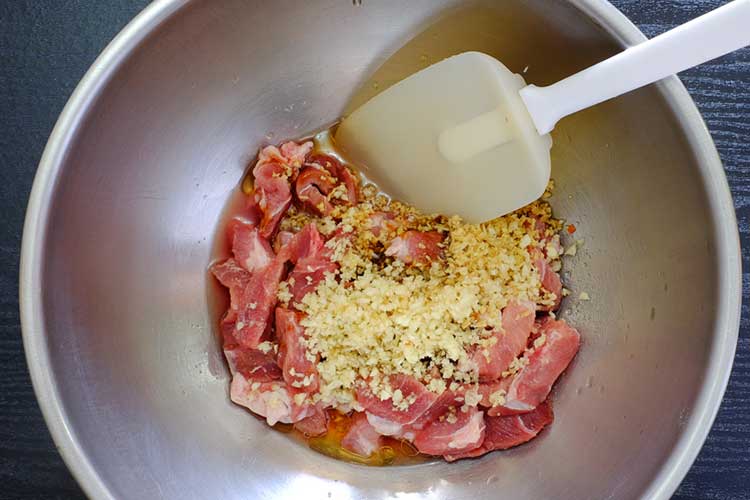
A CHIFA GEM STRAIGHT FROM LIMA’S CHINATOWN
Think of a classic Peruvian dinner, and arroz chaufa might not be the first thing that springs to mind. You might instead conjure up a plate of ceviche or a barbequed cuy (guinea pig!) washed down with a pisco sour.
Spend an evening in Lima, however, and you are just as likely to find yourself tucking into a hearty serving of unique Cantonese-style fried rice.
ABOUT THE RECIPE
To cut to the chase: arroz chaufa is basically Cantonese fried rice that has been well and truly made to feel at home in Peru. It’s simple, delicious and a much-loved basic dish among Peruvians for whom chifa is now seamlessly integrated into the culinary landscape.
What we love about arroz chaufa is its simplicity: there’s very little to making it and the flavors are straightforward. There’s a nice play between Asian and Peruvian ingredients in the mix of ginger, oyster sauce, soy sauce and sesame oil cooking up next to red bell peppers and aji amarillo chilis.
If for any reason you can’t find any aji amarillo chilis, we think serrano peppers would make a very satisfactory substitute.
MARINATING MEAT AND COOKING YOUR OMELETTE
Before getting stuck into the rice, we recommend marinating the meat to maximize the soak time and ramp up the flavor. Get all your ingredients together first. Once you get to the stir fry phase of the arroz chaufa, things are going to move fast, so have everything you need to hand from the beginning.
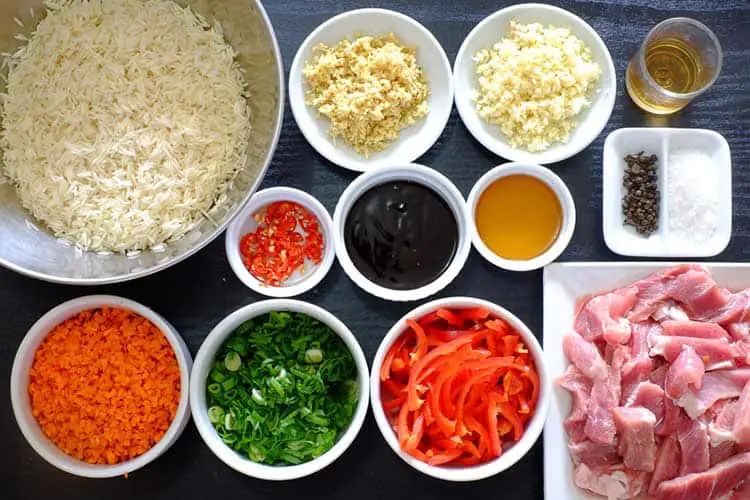
To make the marinade, mix in a bowl the garlic, ginger, oyster sauce, soy sauce, Chinese cooking wine, salt, and ground black pepper. Coat the meat thoroughly, cover the bowl and refrigerate for an hour.

Then beat your eggs in a bowl, adding a pinch of salt. Fry the eggs like an omelette and cut into cubes. Set these aside.

RICE TO THE OCCASION
One of the most important elements of arroz chaufa is, of course, the rice itself. Whether you’re using leftover rice from the day before, or freshly making the rice for your dish today, it’s essential that the grains stay light and fluffy. To that end, we recommend using a long grain rice like Jasmine or Basmati and steering clear of more starchy varieties like Arborio, sushi rice, or glutinous rice.
Next, you simply have to cook it to perfection: if you don’t already have a tried and tested technique, try following our surefire fluffy rice method below.
First, rinse the rice in a bowl under cold running water, until the water becomes clear. This will remove the excess starch which would cause it to stick too much. Then leave it to soak in water for 15 minutes to improve the texture of the rice before cooking.
In general, pre-soaking rice is always an excellent idea. A good long soak make all grains more digestible by breaking down the more complex proteins which inhibit our ability to absorb the nutrients from the grain like iron and magnesium.
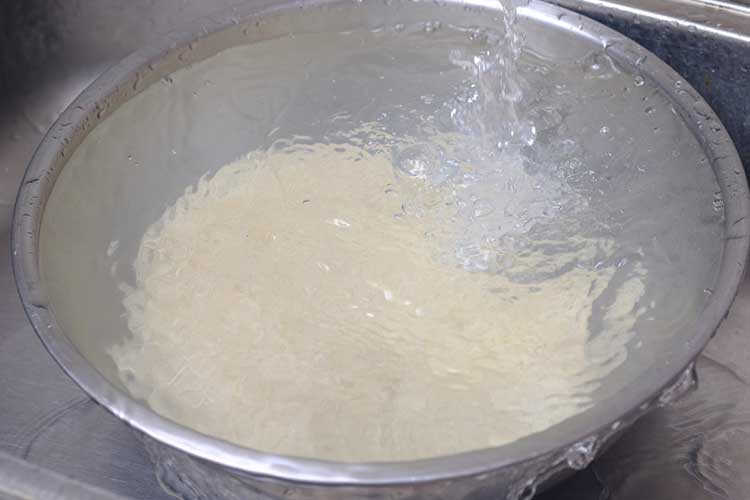
Once you drain the rice, allow it to dry for 10 minutes or so. This will firm it up a bit after the soaking to make it ready for the next step, which is to heat a tablespoon of olive oil in a stockpot and to add the rice, coating the grains evenly with the oil and let them heat up ever so lightly. This process causes the grain to swell and consequently absorb more moisture, ensuring that it cooks perfectly tender.

Next, add the chicken stock, a tablespoon of sesame oil (to make it more fragrant) and about half a tablespoon of salt. Stir well and cover with a lid.
Now turn the heat down to the lowest possible setting and leave like this for exactly 18 minutes. After 18 minutes, turn the heat off but keep the lid on and leave for another 10 minutes to absorb all the steam. Have faith that your unseen rice will be immaculate!

Once it’s done, put spread it out on a tray to cool, fluffing it up with a fork to keep it from sticking and clumping. Let it cool off completely before frying for the same reason.
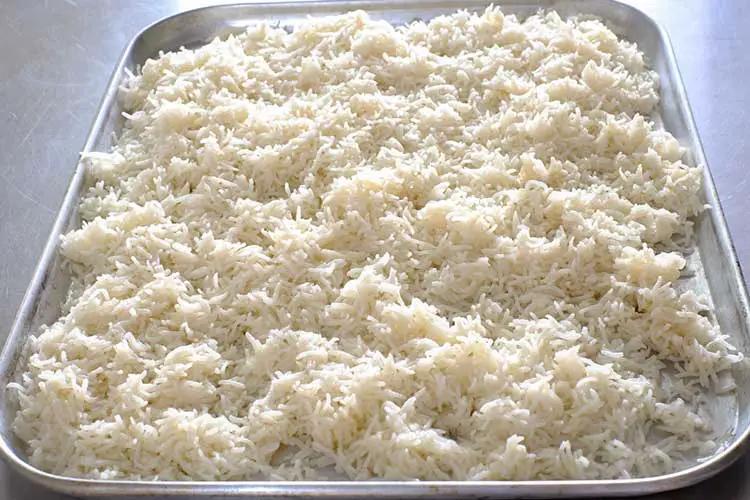
BRACE YOURSELF FOR THE STIR FRY
Stir fries move fast, so you want your ingredients in and out of the pan as quickly as possible. To that end, have everything prepared and close to hand before you start.

Begin by heating the oil, add the garlic and ginger and then the chicken. Keep the meat moving around the pan for two minutes or so.

Now add the carrots and the peppers. Sautee briefly, till they just soften.
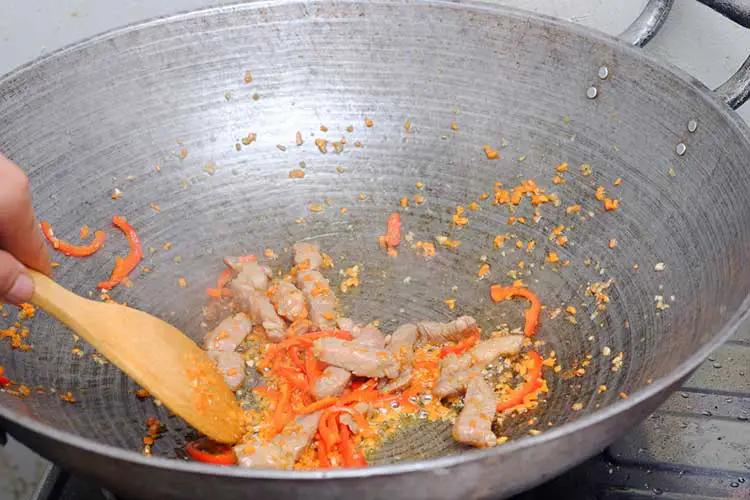
Now add the rice. Stir for another minute and take the wok off the heat.
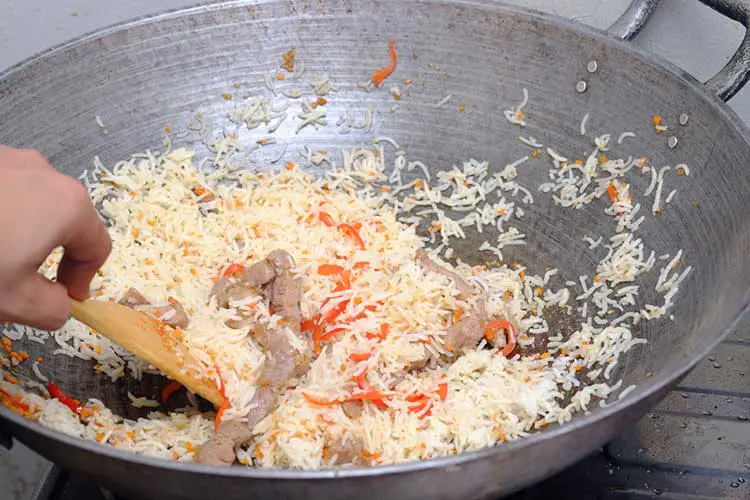
Season with salt, pepper and soy sauce. Drizzle some sesame oil over the rice and finally sprinkle the chopped spring onions.

Finally, top with the egg squares from before. And presto, before you’ve had a moment to realize what’s going on, your arroz chaufa is ready to go. Get busy eating, as it’s best yammed hot and fresh out of the pan.
Eat China but think Peru. It’s that simple!

OUR TAKE ON THE RECIPE
Stir fries look very easy, but they take a good amount of skill and concentration to get the temperature of the oil just right and then to move in a whirlwind of ingredient adding, not leaving anything in the wok for too long to droop, or in one place enough to burn.
There’s the risk of the rice getting too sticky, but we found that by following the method for cooking the Basmati down to the letter and letting it cool completely before putting it to fry in the wok really minimized the stickiness.
We also ended up frying the amount of rice in three batches, as putting it all in the wok at once would have made the overall weight too heavy.
Working from this source recipe for arroz chaufa, we made changes by adding more ingredients like carrots and garlic, as well as oyster sauce to push the Chinese flavors a bit harder and some sesame oil to the rice while it was cooking for a stronger fragrance.
We’ve decided that the next time we make arroz chaufa, we might go stir-fry-crazy and experiment with seafood instead of meat to give the dish a bit more of a flavor kick.
One thing we won’t be trying it with, however, is cuy. Not now, not ever.
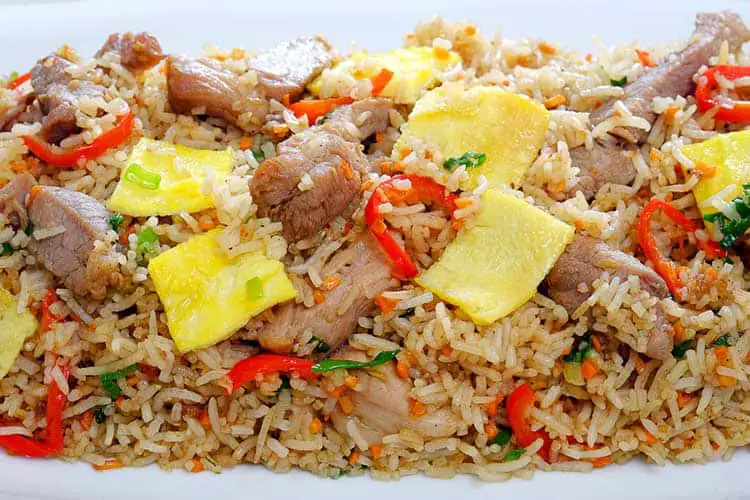


Arroz Chaufa: Peruvian-Cantonese Fried Rice
- Total Time: 20 minutes
Ingredients
- 2 cups Basmati rice
- 4 cups chicken stock
- 1 lb beef sirloin or chicken breast, cut into strips
- 2 tablespoons oyster sauce
- 1 tablespoon Chinese cooking wine
- 3 eggs
- 1 red bell pepper, cut into thin strips
- 2 aji amarillo chilis, finely diced
- 2 medium sized carrots, finely diced
- 4 cloves garlic, finely minced
- 1 1″ piece ginger, finely minced
- 1 handful spring onions, thinly sliced
- Olive oil
- Sesame oil
- Soy sauce
- Salt
- Pepper
Instructions
Stage 1: Preparing Your Ingredients
- Marinate your meat in garlic, ginger, 2 tablespoons oyster sauce, 1 tablespoon soy sauce, 1 tablespoon Chinese cooking wine, 1/2 teaspoon salt, and 1/2 teaspoon ground black pepper. Cover and refrigerate for at least an hour.
- Beat 3 eggs in a bowl with a pinch of salt, then pour them into a pan over medium-high heat.
- Fry the beaten egg for ~1 minute, then cut the cooked omelette into cubes and set aside.
Stage 2: Cooking the Rice
- Put your basmati rice in a large bowl and rinse it under a cold running tap until the water runs clear.
- Next, submerge and soak the rice in fresh water for 15 minutes.
- Drain the rice and allow to air-dry for 10 minutes.
- Heat a tablespoon of olive oil in a stock pot over high-heat, then stir in the rice and coat each grain evenly with oil.
- Ladle in 4 cups of your chicken stock followed by a tablespoon of sesame oil and about half a tablespoon of salt. Stir everything well.
- Bring to a boil, put the lid on, and cook for 18 minutes over the lowest possible simmering setting on your stove.
- After 18 minutes, turn off the heat and keep the lid on for another 10 minutes.
- Finally, fluff the rice gently with a fork and spread it evenly on a tray to cool.
Stage 3: Stir Frying Your Arroz Chaufa
- Heat a tablespoon of olive oil in a wok over high stovetop heat.
- Add your garlic, ginger and meat, then stir-fry for about 2 minutes as the meat starts to sear.
- Add your aji amarillo chilis, bell peppers and carrots, sauteing them briefly as you continue to mix everything around.
- Add rice and stir well for another minute as you season everything with soy sauce, salt, and pepper.
- Drizzle sesame oil over your arroz chaufa and sprinkle in spring onions. Top it with your pieces of cut up omelette, then serve hot. Enjoy!
- Prep Time: 10 min
- Cook Time: 10 min
